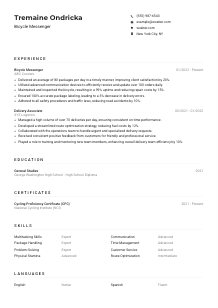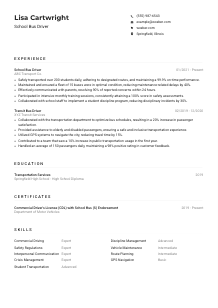Truck Driver Resume Example
Hauling freight, but your resume feels stuck in traffic? Cruise into this Truck Driver resume example, mapped out with Wozber free resume builder. Learn how to steer your driving experience and route knowledge to sync with job posts, ensuring your career moves at the right speed on the open road of opportunities!

How to write a Truck Driver Resume?
Greetings, aspiring Truck Driver! The journey to a standout resume in the logistics world is both an art and a science. With the right tools and insights, crafting an ATS-compliant resume that sails through Applicant Tracking Systems and impresses hiring managers is within reach.
By using the Wozber free resume builder, this guide aims to empower you with targeted tips and professional know-how to create a resume that paves the way for your Truck Driver career. Strap in, and let's gear up to shape your application into a powerhouse of qualifications and dedication.
Personal Details
Let's kick things off by polishing the headlights – the Personal Details section. For a Truck Driver, this area of your resume isn't just about who you are; it's about presenting yourself as a reliable professional ready to take on the road.
1. Name
Envision your name as the brand on your truck – it should be bold and clear. Opt for a legible font that stands out yet remains professional.
2. Job Title
Just below your name, mirror the job title: 'Truck Driver.' This alignment not only shows you're a perfect fit but also helps with ATS optimization.
3. Contact Information
- Phone Number: Your lifeline to potential employers. Ensure it's correct; you wouldn't want a missed connection.
- Professional Email: Keep it simple and professional. A firstname.lastname format works wonders.
4. Location
"Denver, Colorado" is your base camp. Highlighting your readiness to work within the specified location can steer you clear of any relocation concerns.
5. Online Presence
Consider adding a LinkedIn profile if it's polished and reflects your professional journey. Just like ensuring your truck is presentable, your online persona should be too.
Takeaway
Your Personal Details section is the ignition of your resume journey. Ensuring it's precise and professional sets the stage for a powerful first impression. Buckle up; you're off to a great start.





Experience
The Experience section is where the rubber meets the road. It's your chance to showcase the miles you've covered in your career. Here's how to make your journey shine, specifically tailored for the Truck Driver role.
- Transported goods, materials, and equipment to and from specified destinations, ensuring timely deliveries through effective navigation and adherence to routes.
- Maintained daily, precise records of over 200 trips per month, including cargo details and truck conditions, ensuring comprehensive documentation.
- Performed routine maintenance on 3 fleet trucks, resulting in a 99% uptime and ensuring safe and well‑maintained vehicles for operations.
- Initiated in assisting the loading and unloading of over 5000 goods shipments, consistently ensuring item security and zero reported damages.
- Effectively communicated over 50 incidents, including delays and accidents, to the appropriate managers, leading to swift resolution and a reduction of 15% in post‑incident paperwork.
- Delivered 100% of assigned packages within the designated time frame, achieving a top 5% performance ranking.
- Improved delivery routes, resulting in a 10% decrease in fuel consumption and a 5% increase in deliveries per shift.
- Collaborated with customer service teams, receiving commendations for exceptional customer feedback and service.
- Streamlined package handling procedures, reducing damages by 20%.
- Developed a comprehensive pre‑trip checklist, minimizing the risk of vehicle breakdowns by 15%.
1. Break Down
Begin by dissecting the job description. For instance, if it states, 'Proven track record of safe driving,' prepare to highlight your impeccable driving record.
2. Present Roles
List your relevant roles, starting with the most recent. Use the term 'Professional Truck Driver' to resonate with ATS and hiring managers alike.
3. Tailor Achievements
Craft bullet points like, 'Performed routine maintenance on fleet trucks, resulting in a 99% uptime,' to demonstrate your hands-on experience and reliability.
4. Quantify Impact
Where possible, use numbers to drive your point home. Managing 'over 5000 goods shipments' is far more impressive when quantified.
5. Relevance
Ensure every achievement or responsibility listed gears directly towards the Truck Driver role. Off-topic accomplishments won't navigate you closer to an interview.
Takeaway
Your Experience section plots the course of your career. It's essential to steer it directly towards your destination: the Truck Driver position you're aiming for. With detailed, relevant examples, you're on the expressway to success.
Education
In the vast world of truck driving, your Education section might initially seem less critical than experience. However, it's still a valuable segment that can strengthen your resume's foundation. Here's how to maneuver it for your advantage.
1. Key Education
Identify what, if any, educational requirements are listed. Even if not explicitly mentioned for the Truck Driver role, a High School Diploma can be beneficial to list, showcasing your foundational knowledge.
2. Structure
Keep this section clean and simple. List your highest level of education, the institution, and graduation year. For a Truck Driver, concise and to the point wins.
3. Tailor Degree Details
If your education aligns with transport, logistics, or a similar field, make sure to highlight it. If not, simply noting your degree can suffice.
4. Relevant Courses
For newer drivers, mentioning courses related to transportation or safety can add credibility. Otherwise, focus on your practical driving experience.
5. Additional Achievements
Did you excel in a course relevant to truck driving or logistics? Highlighting such achievements can demonstrate commitment and skill beyond the wheel.
Takeaway
Though your Education section might be brief, it's an integral part of the roadmap to your desired Truck Driver role. Clearly presenting your educational background paves the way for a stronger resume.
Certificates
Certificates can be your pathway to standing out as a Truck Driver. They're proof of your dedication to safety, skill enhancement, and professional growth. Let's ensure they're showcased effectively.
1. Key Requirements
Start with the job posting's essentials, like the requirement for a 'valid Commercial Driver's License (CDL).' Highlighting this certification is a direct match with the employer's needs.
2. Prioritize Certificates
If you have additional endorsements or certificates (e.g., Hazmat or Tanker), list these next. They can significantly bolster your application, showing specialized skills.
3. Date Transparency
Be upfront about the validity period of your certificates, especially for those with expiration dates. This transparency showcases your commitment to maintaining your qualifications.
4. Keep Updated
The trucking industry and its regulations evolve. Display your initiative by seeking out new certifications and staying ahead of industry standards.
Takeaway
Your certificates are like badges of honor, symbolizing your expertise and commitment to the profession. Make them prominent. With the right certifications front and center, you're showcasing your readiness to take the helm in your Truck Driver role.
Skills
Your Skills section is like the dashboard of your truck – it displays your operational readiness and efficiency. Here's how to fine-tune it for the Truck Driver position, ensuring it's indicating the right expertise for your journey.
1. Decode Requirements
The job description is your map here. Skills like 'excellent communication' and 'ability to perform routine maintenance on trucks' are your route markers. List these explicitly.
2. Align Skills
Match your skills with the job posting. If you're an expert in 'route planning' and have 'advanced driving safety' knowledge, these should be upfront. Remember, relevance is key.
3. Organized Display
Craft a neat list focusing on the skills most pertinent to a Truck Driver. An ATS-friendly resume format means avoiding overstuffing; keep it focused and impactful.
Takeaway
The Skills section of your resume doesn't just list your competencies; it's proof of your fit for the Truck Driver role you're targeting. Tailor it to mirror the job description, and you'll signal to employers and ATS alike that you're ready to hit the road.
Languages
In an increasingly connected world, your ability to speak multiple languages can distinguish you in the trucking industry. Understanding and communicating in more than one language can be a powerful asset, especially in diverse urban centers or international routes.
1. Job Requirements
Verify if specific languages are preferred or required. For the Truck Driver role, 'good English proficiency' is crucial. List it prominently.
2. Highlight Essential
Position your strongest language skills at the top, specifically those mentioned in the job requirements. This enhances your resume's ATS optimization.
3. Additional Languages
Mentioning other languages can showcase your ability to communicate with diverse teams or clientele. It suggests adaptability - a valued trait.
4. Honesty in Proficiency
Accurately portray your language skills. Overestimation can lead to awkward situations, while underestimation might sell you short. Be precise.
5. Scope of Role
Consider the geographical and demographic context of your driving routes. For regional positions, additional languages might not be as crucial, but for metropolitan or international roles, they could give you an edge.
Takeaway
Whether it's negotiating traffic in Los Angeles or coordinating delivery in Montreal, your ability to bridge language barriers can be a significant advantage. Highlighting your language skills reflects your capability to navigate not just roads but also cultures.
Summary
Your Summary is like the destination on your journey – it's what you're driving towards. Crafting an engaging, concise, and tailored summary can set the tone for your entire resume, inviting the hiring manager to explore further.
1. Job Essence
Distill the job description down to its core elements. For a Truck Driver, this might include 'safe driving,' 'timely deliveries,' and 'effective communication.'
2. Introduction
Start with an engaging opener that positions you as a dedicated professional. Think of it as your handshake or the horn of your truck announcing your arrival.
3. Highlight Achievements
Mention standout accomplishments or skills that align with the job's needs. Phrases like 'recognized for outstanding communication skills' demonstrate your suitability for the role.
4. Brevity
Keep it concise. Your summary should be a trailer, not the full movie. Aim for 3-5 compelling lines that entice the hiring manager to dive deeper into your resume.
Takeaway
The Summary section is your opportunity to grab attention and make a memorable first impression. Like a well-mapped route, it guides the reader through your professional landscape, highlighting why you're the right Truck Driver for the job. With each word, you're getting closer to your destination: landing the role.
Launching Your Truck Driver Journey
With this comprehensive guide, you're now equipped with the tools and knowledge to craft a resume that stands out in the trucking industry. Remember, your resume is more than a document; it's a reflection of your professional journey, dedication, and readiness for new challenges. By tailoring each section to mirror your unique experiences and the specific Truck Driver role, you're not just applying for a job - you're positioning yourself as the ideal candidate.
Use the Wozber free resume builder to ensure your resume is not only ATS-compliant but also a testament to your capabilities. Turn the key, your road to success awaits!

- Minimum of 2 years of experience as a professional truck driver.
- Possession of a valid Commercial Driver's License (CDL) with applicable endorsements, such as Hazmat or Tanker, where required by the position.
- Proven track record of safe driving and adherence to traffic laws and regulations.
- Excellent communication and customer service skills.
- Ability to perform routine maintenance on trucks and ensure all required inspections are completed.
- Must have good English proficiency.
- Must be located in or willing to relocate to Denver, Colorado.
- Transport goods, materials, and equipment to and from specified destinations following prescribed routes, ensuring timely deliveries.
- Maintain daily, accurate records of trips, cargo, and truck condition.
- Perform pre-trip and post-trip inspections to ensure the truck is safe and well-maintained.
- Assist with loading and unloading of goods, ensuring items are secured properly for transportation.
- Communicate any delays, accidents, or incident reports to the appropriate managers and complete necessary paperwork.















